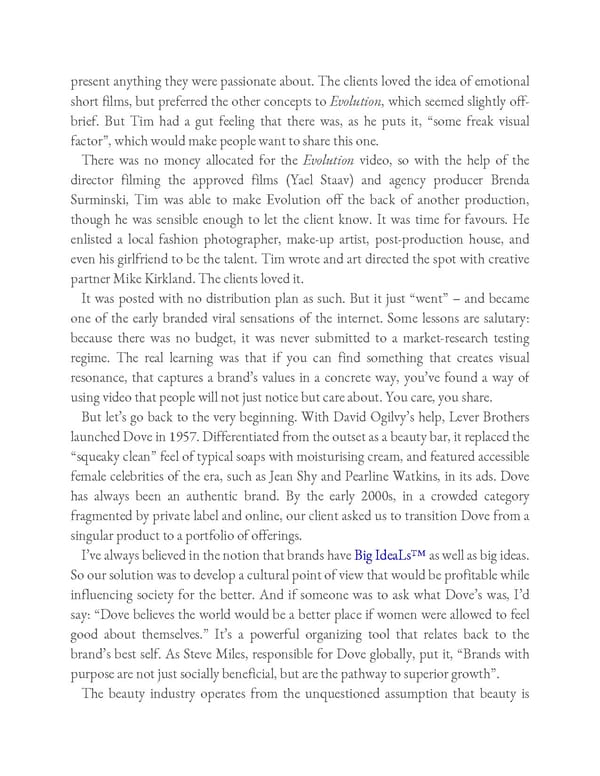present anything they were passionate about. The clients loved the idea of emotional short films, but preferred the other concepts to Evolution, which seemed slightly off- brief. But Tim had a gut feeling that there was, as he puts it, “some freak visual factor”, which would make people want to share this one. There was no money allocated for the Evolution video, so with the help of the director filming the approved films (Yael Staav) and agency producer Brenda Surminski, Tim was able to make Evolution off the back of another production, though he was sensible enough to let the client know. It was time for favours. He enlisted a local fashion photographer, make-up artist, post-production house, and even his girlfriend to be the talent. Tim wrote and art directed the spot with creative partner Mike Kirkland. The clients loved it. It was posted with no distribution plan as such. But it just “went” – and became one of the early branded viral sensations of the internet. Some lessons are salutary: because there was no budget, it was never submitted to a market-research testing regime. The real learning was that if you can find something that creates visual resonance, that captures a brand’s values in a concrete way, you’ve found a way of using video that people will not just notice but care about. You care, you share. But let’s go back to the very beginning. With David Ogilvy’s help, Lever Brothers launched Dove in 1957. Differentiated from the outset as a beauty bar, it replaced the “squeaky clean” feel of typical soaps with moisturising cream, and featured accessible female celebrities of the era, such as Jean Shy and Pearline Watkins, in its ads. Dove has always been an authentic brand. By the early 2000s, in a crowded category fragmented by private label and online, our client asked us to transition Dove from a singular product to a portfolio of offerings. I’ve always believed in the notion that brands have Big IdeaLs™ as well as big ideas. So our solution was to develop a cultural point of view that would be profitable while influencing society for the better. And if someone was to ask what Dove’s was, I’d say: “Dove believes the world would be a better place if women were allowed to feel good about themselves.” It’s a powerful organizing tool that relates back to the brand’s best self. As Steve Miles, responsible for Dove globally, put it, “Brands with purpose are not just socially beneficial, but are the pathway to superior growth”. The beauty industry operates from the unquestioned assumption that beauty is
 Ogilvy on Advertising in the Digital Age Page 82 Page 84
Ogilvy on Advertising in the Digital Age Page 82 Page 84